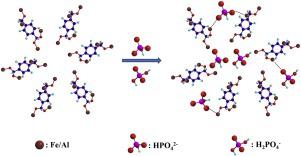当前位置:
X-MOL 学术
›
Process Saf. Environ. Prot.
›
论文详情
Our official English website, www.x-mol.net, welcomes your feedback! (Note: you will need to create a separate account there.)
Tuning the structure flexibility of metal-organic frameworks via adjusting precursor anionic species for selective removal of phosphorus
Process Safety and Environmental Protection ( IF 7.8 ) Pub Date : 2020-11-01 , DOI: 10.1016/j.psep.2020.05.054 Shengjian Li , Meng Liu , Chun Yin , Jing Chen , Xiangjun Yang , Shixiong Wang
Process Safety and Environmental Protection ( IF 7.8 ) Pub Date : 2020-11-01 , DOI: 10.1016/j.psep.2020.05.054 Shengjian Li , Meng Liu , Chun Yin , Jing Chen , Xiangjun Yang , Shixiong Wang

|
Abstract This study proposes a new strategy for manufacturing metal-organic frameworks (MOFs) with respective topologies and properties by adjusting the anionic species in the precursor solution. Three MOFs (e.g. Fe/Al (Cl−), Fe/Al (NO3−) and Fe/Al (SO42−)) were successfully synthesized and used for removal of phosphate from water. Surprisingly, when chlorinated salt was used as the precursor, only Al was detected in the Fe/Al (Cl−). However, when nitrate and sulfate were used as the precursors, Fe and Al were simultaneously detected in the Fe/Al (NO3−) and Fe/Al (SO42−). These MOFs exhibit ultrafast adsorption kinetics and high uptake capacity for phosphate. The maximum phosphate uptake capacity (130 mg P/g) of Fe/Al (NO3−) is much higher than that of most phosphate removal materials reported in the literature. More importantly, Fe/Al (NO3−) can still effectively remove phosphate from water bodies after multiple cycles of adsorption/desorption. When there are a large number of common interfering ions (Ca2+, Mg2+, CO32-, HCO3−, Cl−, NO3− and SO42−) in the water, the prepared MOFs can still specifically remove phosphorus from water. In addition, the prepared MOFs can adapt to the removal of phosphorus in a wide pH water body. Furthermore, based on FTIR and XPS spectra, chemical adsorption and ligand exchange were identified as the main phosphorus removal mechanisms by Fe/Al (NO3−). These findings prefigure that MOFs synthesized by regulating the anionic species can efficiently and economically remove phosphate from water.
中文翻译:

通过调节前体阴离子物质选择性去除磷来调节金属有机骨架的结构灵活性
摘要 本研究提出了一种通过调整前驱体溶液中的阴离子物种来制造具有各自拓扑结构和性质的金属有机框架 (MOF) 的新策略。成功合成了三种 MOF(例如 Fe/Al (Cl-)、Fe/Al (NO3-) 和 Fe/Al (SO42-))并用于去除水中的磷酸盐。令人惊讶的是,当氯化盐用作前体时,在 Fe/Al (Cl-) 中仅检测到 Al。然而,当使用硝酸盐和硫酸盐作为前体时,在 Fe/Al (NO3-) 和 Fe/Al (SO42-) 中同时检测到 Fe 和 Al。这些 MOF 表现出超快的吸附动力学和对磷酸盐的高吸收能力。Fe/Al (NO3-) 的最大磷酸盐吸收能力 (130 mg P/g) 远高于文献中报道的大多数磷酸盐去除材料。更重要的是,Fe/Al (NO3−) 在多次吸附/解吸循环后仍能有效去除水体中的磷酸盐。当水中存在大量常见干扰离子(Ca2+、Mg2+、CO32-、HCO3-、Cl-、NO3-和SO42-)时,制备的MOFs仍然可以特异性去除水中的磷。此外,所制备的 MOFs 可以适应宽 pH 水体中的除磷。此外,基于 FTIR 和 XPS 光谱,化学吸附和配体交换被确定为 Fe/Al (NO3−) 的主要除磷机制。这些发现预示着通过调节阴离子种类合成的 MOF 可以有效且经济地从水中去除磷酸盐。当水中存在大量常见干扰离子(Ca2+、Mg2+、CO32-、HCO3-、Cl-、NO3-和SO42-)时,制备的MOFs仍能特异性去除水中的磷。此外,所制备的 MOFs 可以适应宽 pH 水体中的除磷。此外,基于 FTIR 和 XPS 光谱,化学吸附和配体交换被确定为 Fe/Al (NO3−) 的主要除磷机制。这些发现预示着通过调节阴离子种类合成的 MOF 可以有效且经济地从水中去除磷酸盐。当水中存在大量常见干扰离子(Ca2+、Mg2+、CO32-、HCO3-、Cl-、NO3-和SO42-)时,制备的MOFs仍然可以特异性去除水中的磷。此外,所制备的 MOFs 可以适应宽 pH 水体中的除磷。此外,基于 FTIR 和 XPS 光谱,化学吸附和配体交换被确定为 Fe/Al (NO3−) 的主要除磷机制。这些发现预示着通过调节阴离子种类合成的 MOF 可以有效且经济地从水中去除磷酸盐。化学吸附和配体交换被确定为 Fe/Al (NO3−) 的主要除磷机制。这些发现预示着通过调节阴离子种类合成的 MOF 可以有效且经济地从水中去除磷酸盐。化学吸附和配体交换被确定为 Fe/Al (NO3−) 的主要除磷机制。这些发现预示着通过调节阴离子种类合成的 MOF 可以有效且经济地从水中去除磷酸盐。
更新日期:2020-11-01
中文翻译:

通过调节前体阴离子物质选择性去除磷来调节金属有机骨架的结构灵活性
摘要 本研究提出了一种通过调整前驱体溶液中的阴离子物种来制造具有各自拓扑结构和性质的金属有机框架 (MOF) 的新策略。成功合成了三种 MOF(例如 Fe/Al (Cl-)、Fe/Al (NO3-) 和 Fe/Al (SO42-))并用于去除水中的磷酸盐。令人惊讶的是,当氯化盐用作前体时,在 Fe/Al (Cl-) 中仅检测到 Al。然而,当使用硝酸盐和硫酸盐作为前体时,在 Fe/Al (NO3-) 和 Fe/Al (SO42-) 中同时检测到 Fe 和 Al。这些 MOF 表现出超快的吸附动力学和对磷酸盐的高吸收能力。Fe/Al (NO3-) 的最大磷酸盐吸收能力 (130 mg P/g) 远高于文献中报道的大多数磷酸盐去除材料。更重要的是,Fe/Al (NO3−) 在多次吸附/解吸循环后仍能有效去除水体中的磷酸盐。当水中存在大量常见干扰离子(Ca2+、Mg2+、CO32-、HCO3-、Cl-、NO3-和SO42-)时,制备的MOFs仍然可以特异性去除水中的磷。此外,所制备的 MOFs 可以适应宽 pH 水体中的除磷。此外,基于 FTIR 和 XPS 光谱,化学吸附和配体交换被确定为 Fe/Al (NO3−) 的主要除磷机制。这些发现预示着通过调节阴离子种类合成的 MOF 可以有效且经济地从水中去除磷酸盐。当水中存在大量常见干扰离子(Ca2+、Mg2+、CO32-、HCO3-、Cl-、NO3-和SO42-)时,制备的MOFs仍能特异性去除水中的磷。此外,所制备的 MOFs 可以适应宽 pH 水体中的除磷。此外,基于 FTIR 和 XPS 光谱,化学吸附和配体交换被确定为 Fe/Al (NO3−) 的主要除磷机制。这些发现预示着通过调节阴离子种类合成的 MOF 可以有效且经济地从水中去除磷酸盐。当水中存在大量常见干扰离子(Ca2+、Mg2+、CO32-、HCO3-、Cl-、NO3-和SO42-)时,制备的MOFs仍然可以特异性去除水中的磷。此外,所制备的 MOFs 可以适应宽 pH 水体中的除磷。此外,基于 FTIR 和 XPS 光谱,化学吸附和配体交换被确定为 Fe/Al (NO3−) 的主要除磷机制。这些发现预示着通过调节阴离子种类合成的 MOF 可以有效且经济地从水中去除磷酸盐。化学吸附和配体交换被确定为 Fe/Al (NO3−) 的主要除磷机制。这些发现预示着通过调节阴离子种类合成的 MOF 可以有效且经济地从水中去除磷酸盐。化学吸附和配体交换被确定为 Fe/Al (NO3−) 的主要除磷机制。这些发现预示着通过调节阴离子种类合成的 MOF 可以有效且经济地从水中去除磷酸盐。



























 京公网安备 11010802027423号
京公网安备 11010802027423号